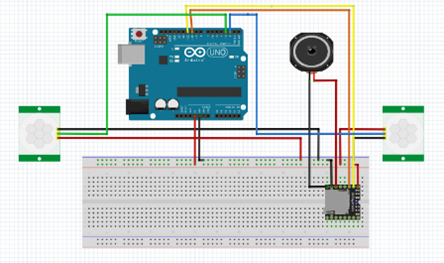Arduino-based Automatic Greeting with PIR Sensor at Angkringan Mukti Kebumen
##plugins.themes.academic_pro.article.main##
Abstract
A waiter is a team member in a restaurant or store responsible for welcoming new arrivals or seeing off departing customers, particularly at the main entrance of the establishment. Currently, the process of welcoming customers relies entirely on human workers, which consumes both time and effort. Therefore, an automated welcoming system is needed to enhance efficiency in terms of time and energy. In this study, the research and development method is employed. The automated welcoming system is built on Arduino technology, involving the use of PIR sensors, Arduino Uno R3, DFPlayer, and a Speaker. During the testing of this product, PIR sensors are utilized as human motion detectors. Arduino Uno R3 functions as the brain of the system, receiving data from the PIR sensors. When the first PIR sensor detects motion, Arduino Uno R3 activates the DFPlayer to play sound through the Speaker. If the second PIR sensor detects motion, the first PIR sensor is turned off for 3 seconds. This product has the capability to detect motion up to a maximum distance of 3 meters.
##plugins.themes.academic_pro.article.details##

This work is licensed under a Creative Commons Attribution-NonCommercial 4.0 International License.
References
[2] I. M. Ridwan, A. Fauzi, I. Aisyah, Susilawati, and I. Sofyan, “Penerapan Digital Marketing Sebagai Peningkatan Pemasaran Pada UKM Warung Angkringan ‘WAGE’ Bandung,” JURNAL ABDIMAS BSI, vol. 2, no. 1, pp. 137–142, 2019.
[3] A. Tafrikhatin, “Penerapan Kran Otomatis Guna Pencegahan Covid-19 untuk Masjid Jami Al-Istiqomah di Kelurahan Setrojenar, Kecamatan Buluspesantren, Kabupaten Kebumen,” JURPIKAT (Jurnal Pengabdian Kepada Masyarakat), vol. 1, no. 2, pp. 48–59, Oct. 2020, doi: 10.37339/jurpikat.v1i2.306.
[4] A. Tafrikhatin and Dwi Sri Sugiyanto, “Handsanitizer Otomatis Menggunakan Sensor Ultrasonik Berbasis Atmega 328 Guna Pencegahan Penularan Virus Corona,” Jurnal E-Komtek (Elektro-Komputer-Teknik), vol. 4, no. 2, pp. 127–135, Dec. 2020, doi: 10.37339/e-komtek.v4i2.394.
[5] S. Ahadiah and T. Elektro Politeknik Negeri Bengkalis, “IMPLEMENTASI SENSOR PIR PADA PERALATAN ELEKTRONIK BERBASIS MICROCONTROLLER,” Jurnal Inovtek Polbeng, vol. 07, no. 1, pp. 29–34, 2017.
[6] HasbyFachrul, S Sumarno, F. Anggaini, I. Parlina, and Z. M. Nasution, “Rancang Bangun Bel Otomatis pada STIKOM Tunas Bangsa Berbasis Arduino dengan Output Suara,” BULLETIN OF COMPUTER SCIENCE RESEARCH, vol. 1, no. 3, pp. 63–70, 2021.
[7] R. Alamsyah and Allwine, “Arduino-Based Automatic Sliding Door Design,” Jurnal Mantik, vol. 4, no. 1, pp. 230–237, 2020.
[8] S. A. Akinwumi, A. C. Ezenwosu, T. V Omotosho, O. O. Adewoyin, T. A. Adagunodo, and K. D. Oyeyemi, “Arduino Based Security System using Passive Infrared (PIR) Motion Sensor,” IOP Conf Ser Earth Environ Sci, vol. 655, no. 1, p. 012039, Feb. 2021, doi: 10.1088/1755-1315/655/1/012039.
[9] A. P. Siregar et al., “Upaya Pengembangan Industri Batik di Indonesia,” Dinamika Kerajinan dan Batik: Majalah Ilmiah, vol. 37, no. 1, pp. 79–92, Jun. 2020, doi: 10.22322/dkb.v37i1.5945.
[10] Arba’i Yusuf, E. P. Nasution, Asni Tafrikhatin, and Ajeng Tiara Wulandari, “Rancang Bangun Alat Pendeteksi Kebocoran Gas LPG Dengan Sensor Mq-6 Berbasis Mikrokontroler Melalui Telegram,” JASATEC?: Journal of Students of Automotive, Electronic and Computer, vol. 2, no. 1, pp. 1–8, Jun. 2023, doi: 10.37339/jasatec.v2i1.1230.

